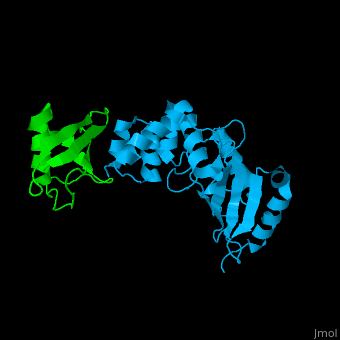Function
Ubiquitin (UBB) is found in almost all cells. It binds to proteins tagging them for destruction in the proteasome. UBB is activated by the UBB-activating enzymes E1, E2 and E3. Ubiquitin+1 is a frameshifted mutant of UBB observed in several diseases. A dimer of UBB (DiUBB) is formed by linkage of K48 to the C-terminus of a second UBB molecule. Polyubiquitin (polyUBB) is a chain of ubiquitin molecules bound by peptide bonds. PolyUBB can be formed by lysine residues: K6, K11, K27, 29, K33, K48, and K63. Different lysine linkages convey different functions to polyUBB. Lys48- linked polyUBB and LYs11-linked polyUBB are associated with proteasome degradation; Lys63-linked and Lys-6 polyUBB are associated with non-proteolytic functions[1]. At least 4 UBB molecules are needed to tag a protein for the proteasome[2]. (3k9p). For details see
Professors Ciechanover, Hershko and Rose received the Nobel Prize in 2004 for their discovery of the process by which ubiquitin mediates protein proteolysis[3].
Additional Resources
See also:
Disease
The UBB-proteasome system deregulation has been implicated in the pathogenesis of many neurodegenerative disorders like Alzheimer's disease, Parkinson disease, Huntington disease, Prion-like lethal disorders and in genetic diseases like cystic fibrosis, angelman's syndrome, Liddle syndrome and many cancers[4].

